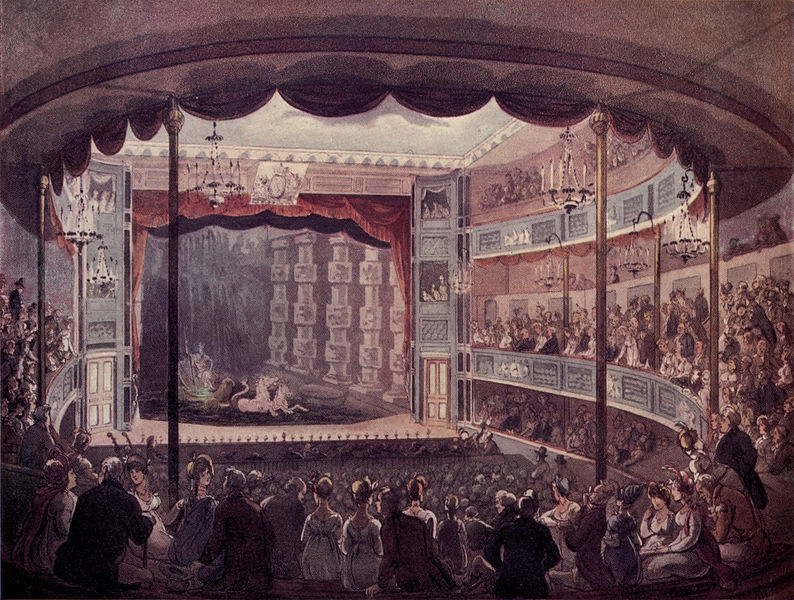My ideas come from all over, but the primary place they come from is research. Here are no less than FOUR wonderful settings or hooks for a romance that I came across just this week!
1. Humphrey Ravenscroft, inventor of the forensic wig. I came upon him while trying to decide if Regency footmen would powder their wigs, or wear wigs that were already white (my reluctant conclusion: probably powder). The website of Ede & Ravenscroft (makers of forensic wigs to this day! Here’s Freema Agyeman rocking a modern-day legal wig on Law & Order UK) informed me that in 1822, “Humphrey Ravenscroft (1748 – 1851), grandson of the founder, finally perfects and patents a wig made of white horsehair that needs no powdering or curling. This is the famous forensic wig, whose pattern is still used today.”
The patent states more fully: “for the invention of a Forensic Wig, the curls whereof are constructed upon a principle to supersede the necessity of frizzing, curling, or using hard pomatums, and for forming the Curls in a way not to be uncurled; and also for the Tails of the Wig not to require tying in dressing; and further the impossibility of any person untying them.”
The technical details of construction are included. The wig supposedly also stayed clean, didn’t smell, and could be folded and carried in a tin without damaging it!
For a picture of a period wig (although I suspect the dating is too early), here is one on Pinterest, and another one c. 1830 with some wonderful close-ups.
I would read SO MANY romances about this guy inventing his wig! And what a name.
2. A play performed at Sadler’s Wells Theatre, April-May 1804, advertised as “a grand Naval spectacle, presenting that memorable monument of British Glory, the Siege of Gibralter; with an exact representation of the armament both by Land and Sea, of the combined forces of France and Spain, with real Men of War and Floating Batteries, built and rigged by professional men from His Majesty’s Dock Yards, and which float in a receptacle containing nearly 8000 cubic feet of real water.”

Sadler’s Wells Theatre putting on what looks like another aquatic spectacle c. 1808, from Rowlandson and Pugin’s Microcosm of London. Image via Wikimedia Commons
Later advertising elaborated that there were: “real ships of 100, 74, and 60 guns, &c., built, rigged, and manoeuvred in the most correct manner, as every nautical character who has seen them implicitly allows, which work down with the wind on their starboard beam, wear and haul the wind on their larboard tacks, to regain their situations, never attempted at any Theatre in this or any other country: the ships firing their broadsides, the conflagration of the town in various places, the defence of the garrison, and attack by the floating batteries, is so faithfully and naturally represented, that when the floating batteries take fire, some blowing up with a dreadful explosion, and others, after burning to the water’s edge, sink to the bottom; while the gallant Sir Roger Curtis appears in his boat to save the drowning Spaniards, the British tars for that purpose plunging into the water, the effect is such as to produce an unprecedented climax of astonishment and applause.”
(Quoted in Nicoll’s A History of English Drama.)
I can’t even begin to grasp the romantic possibilities. You’ve got set designers, engineers, military and technical advisors, everyone in the theater and its company, possible Navy men in the audience, dangerous effects and stunts…I WANT TO READ A BOOK ABOUT THIS SO BADLY.
3. “A tontine is an investment plan for raising capital, devised in the 17th century and relatively widespread in the 18th and 19th centuries. It combines features of a group annuity and a lottery. Each subscriber pays an agreed sum into the fund, and thereafter receives an annuity. As members die, their shares devolve to the other participants, and so the value of each annuity increases. On the death of the last member, the scheme is wound up. In a variant, which has provided the plot device for most fictional versions, upon the death of the penultimate member the capital passes to the last survivor.” (Wikipedia)
(I came across this because the building of the new Chichester theatre was funded by tontine in 1792, headed up by the Duke of Richmond, whom you may remember from his wife’s famous ball on the eve of Waterloo.)
OH MY GOD. There have apparently been a lot of TV episodes and murder mysteries involving tontines, but I’d never heard of it and I have CERTAINLY never seen it in a historical romance! Someone PLEASE get on that.
4. In looking something up for the online course on Regency politics I’m currently teaching, I discovered this in Judith Lewis’s Sacred to Female Patriotism:
“Donald McAdams [Rose’s note: I definitely just typed Douglas Adams]…confirms that in 1784, ‘many Bristol girls had bogus wedding ceremonies which were declared void at the close of the poll,’ while in Great Grimsby in 1790 he recounts that there were sixty weddings immediately prior to the election.”
(Bristol and Great Grimsby were boroughs where daughters of freemen could confer voting privileges on their husbands.)
Okay. OMG. Mass weddings! Bogus marriages which were quickly annuled! How was that even legally possible?? I want to know EVERYTHING. I especially want a screwball comedy–style romance about a couple who just married for the election and are planning to annul it later…except then neither of them really wants to.
Which of these would you most like to see? What historical factoid do you think would be a great subject for a romance?

